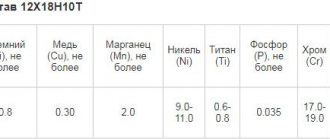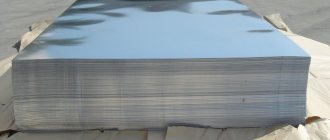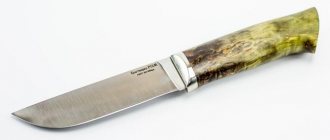We will advise you on any questions!
Any specialist who deals with metal is familiar with the concept of “steel grade”. Deciphering the markings of steel alloys makes it possible to get an idea of their chemical composition and physical characteristics. Understanding this marking, despite its apparent complexity, is quite simple - it is only important to know on what principle it is compiled.
Rarely does production operate without steel, so understanding its grades is extremely important
The alloy is designated by letters and numbers, which can be used to accurately determine which chemical elements it contains and in what quantity. Knowing this, as well as how each of these elements can affect the finished alloy, it is possible to determine with a high degree of probability exactly what technical characteristics are characteristic of a particular grade of steel.
Types of steels and features of their markings
Steel is an alloy of iron and carbon, the content of which is no more than 2.14%. Carbon gives the alloy hardness, but if it is in excess, the metal becomes too brittle.
One of the most important parameters by which steels are divided into different classes is the chemical composition. Among the steels according to this criterion, alloyed and carbon steels are distinguished, the latter are divided into low-carbon (carbon up to 0.25%), medium-carbon (0.25–0.6%) and high-carbon (they contain more than 0.6% carbon).
Types of steels
By including alloying elements in the steel, it can be given the required characteristics. It is in this way that, by combining the type and quantitative content of additives, grades with improved mechanical properties, corrosion resistance, magnetic and electrical characteristics are obtained. Of course, it is possible to improve the characteristics of steels using heat treatment, but alloying additives make it possible to do this more efficiently.
Based on the quantitative composition of alloying elements, low-, medium- and high-alloy alloys are distinguished. In the first alloying elements there is no more than 2.5%, in medium alloyed elements - 2.5–10%, in highly alloyed ones - more than 10%.
Steels are classified according to their purpose. Thus, there are instrumental and structural types, grades distinguished by special physical properties. Tool types are used for the production of stamping, measuring, and cutting tools, structural ones - for the production of products used in construction and mechanical engineering. Alloys with special physical properties (also called precision) are used to make products that must have special characteristics (magnetic, strength, etc.).
Classification of steels by purpose
Steels are also contrasted with each other based on their special chemical properties. Alloys of this group include stainless, scale-resistant, heat-resistant, etc. Typically, stainless steels can be corrosion-resistant and stainless steel for food - these are different categories.
In addition to useful elements, steel also contains harmful impurities, the main ones of which are sulfur and phosphorus. It also contains gases in an unbound state (oxygen and nitrogen), which negatively affects its characteristics.
If we consider the main harmful impurities, phosphorus increases the brittleness of the alloy, which is especially pronounced at low temperatures (the so-called cold brittleness), and sulfur causes cracks in metal heated to high temperatures (red brittleness). Phosphorus, among other things, significantly reduces the ductility of heated metal. Based on the quantitative content of these two elements, steels are divided into ordinary quality (no more than 0.06–0.07% sulfur and phosphorus), high-quality (up to 0.035%), high-quality (up to 0.025%) and especially high-quality (sulfur - up to 0.015%, phosphorus - up to 0.02%).
The marking of steels also indicates to what extent oxygen has been removed from their composition. According to the level of deoxidation, steels are divided into:
- calm type, designated by the letter combination “SP”;
- semi-calm - “PS”;
- boiling - “KP”.
Analogs
If you don’t delve too deeply into the definition, then U10A-7KhNM can be considered Damascus steel, at least it has quite a lot in common with them. This means that this broad subspecies of metals can be considered its analogues.
In terms of its properties, ZD-0803 is very similar to U10A-7ХНМ. It also combines high cutting performance, resistance to heavy loads, but requires simple maintenance. Its hardening is also within 59-60 HRC.
Another analogue, the characteristics of which are also somewhat reminiscent of the U10A-7ХНМ, is 40Х13-Х12Ф1. This is a high-alloy steel grade with increased hardness. Used for cutting, measuring tools, household items, items that require wear and tear, such as springs, bearings, etc.). This is a popular steel with good corrosion resistance.
Previous
KnivesSteel Elmax: characteristics
Next
KnivesSteel 9Cr18MoV
What does the steel marking mean?
It has become quite easy to decipher the brand; you just need to have certain information. Structural steels of ordinary quality and not containing alloying elements are marked with the letter combination “St”. By the number following the letters in the name of the brand, you can determine how much carbon is in such an alloy (calculated in tenths of a percent). The numbers may be followed by the letters “KP”: from them it becomes clear that this alloy has not completely gone through the deoxidation process in the furnace, and accordingly, it belongs to the boiling category. If the brand name does not contain such letters, then the steel corresponds to the calm category.
Chemical composition of carbon structural steels of ordinary quality
Structural unalloyed steel, which belongs to the quality category, has two numbers in its designation; they are used to determine the average carbon content in it (calculated in hundredths of a percent).
Before we begin to consider the grades of those steels that include alloying additives, you should understand how these additives are designated. Marking of alloy steels may include the following letter designations:
List of alloying additives used
Designation of steels with alloying elements
As mentioned above, the classification of steels with alloying elements includes several categories. The marking of alloy steels is compiled according to certain rules, knowledge of which allows one to quite simply determine the category of a particular alloy and the main area of its application. In the initial part of the names of such brands there are numbers (two or one) indicating the carbon content. Two numbers indicate its average content in the alloy in hundredths of a percent, and one – in tenths. There are also steels that do not have numbers at the beginning of the brand name. This means that the carbon content in these alloys is within 1%.
Example of alloy steel marking
The letters that can be seen behind the first digits of the brand name indicate what the alloy is made of. The letters that give information about a particular element in its composition may or may not be followed by numbers. If there is a number, then it determines (in whole percentages) the average content of the element indicated by the letter in the alloy, and if there is no number, it means that this element is contained in the range from 1 to 1.5%.
At the end of the marking of certain types of steel there may be the letter “A”. This suggests that this is high quality steel. These grades may include carbon steels and alloys with alloying additives in their composition. According to the classification, this category of steels includes those in which sulfur and phosphorus amount to no more than 0.03%.
Mechanical properties steel 10
| GOST | Type of delivery, heat treatment mode | σв(MPa) | δ5 (%) | ψ % | NV, no more |
| 1050-88 | Hot-rolled steel, forged calibrated steel and silver steel of the 2nd category after normalization | 335 | 31 | 55 | |
| 10702-78 | Steel calibrated and calibrated with special finishing: | ||||
| after annealing or tempering | 335-450 | 55 | 143 | ||
| after spherodizing holiday | 315-410 | 55 | 143 | ||
| cold-worked without heat treatment | 390 | 8 | 50 | 187 | |
| 1577-93 | Normalized or hot rolled strips | 335 | 8 | 55 | |
| 16523-70 | Hot rolled sheet (transverse samples) | 295-410 | 24 | ||
| Cold rolled sheet (transverse samples) | 295-410 | 25 | |||
| 4041-71 | Heat-treated sheet of category 1-2 | 295-420 | 32 | 117 | |
| 8731-87 | Hot-deformed, heat-treated pipes | 355 | 24 | 137 | |
| 8733-87 | Cold- and heat-deformed heat-treated pipes | 345 | 24 | 137 | |
| Cementation 920-950 °C. Quenching 790-810 °C, water. Vacation 180-200 °C, air. | 390 | 25 | 55 | hearts 137 surface 57-63 |
Examples of marking steels of various types
Determining the grade of steel and assigning an alloy to a certain type is a task that should not cause any problems for a specialist. You don’t always have a table at hand that gives a breakdown of brand names, but the examples given below will help you figure it out.
Content of elements in common steel grades (click to enlarge)
Structural steels that do not contain alloying elements are designated by the letter combination “St”. The numbers following are the carbon content, calculated in hundredths of a percent. Low-alloy structural steels are marked somewhat differently. For example, 09G2S steel contains 0.09% carbon, and alloying additives (manganese, silicon, etc.) are contained within 2.5%. 10KhSND and 15KhSND, which are very similar in their markings, differ in different amounts of carbon, and the share of each alloying element in them is no more than 1%. That is why there are no numbers after the letters indicating each alloying element in such an alloy.
20Х, 30Х, 40Х, etc. – this is how structural alloy steels are marked; the predominant alloying element in them is chromium. The number at the beginning of such a mark is the carbon content in the alloy in question, calculated in hundredths of a percent. The letter designation of each alloying element can be followed by a number, which is used to determine its quantitative content in the alloy. If it is not there, then the specified element in the steel contains no more than 1.5%.
You can consider an example of the designation of chromium-silicon-manganese steel 30KhGSA. According to the labeling, it consists of carbon (0.3%), manganese, silicon, and chromium. It contains 0.8–1.1% of each of these elements.
Physical properties of steel 10
| Temperature | E 10- 5 | a 10 6 | l | r | C | R 10 9 |
| 0C | MPa | 1/Grad | W/(m deg) | kg/m3 | J/(kg deg) | Ohm m |
| 20 | 2.1 | 7856 | 140 | |||
| 100 | 2.03 | 12.4 | 57 | 7832 | 494 | 190 |
| 200 | 1.99 | 13.2 | 53 | 7800 | 532 | 263 |
| 300 | 1.9 | 13.9 | 49.6 | 7765 | 565 | 352 |
| 400 | 1.82 | 14.5 | 45 | 7730 | 611 | 458 |
| 500 | 1.72 | 14.85 | 39.9 | 7692 | 682 | 584 |
| 600 | 1.6 | 15.1 | 35.7 | 7653 | 770 | 734 |
| 700 | 15.2 | 32 | 7613 | 857 | 905 | |
| 800 | 12.5 | 29 | 7582 | 875 | 1081 | |
| 900 | 14.8 | 27 | 7594 | 795 | 1130 | |
| 1000 | 12.6 | 666 | ||||
| 1100 | 14.4 | 668 |
At a temperature of +20 0C, the density of steel is 7856 kg/m3
How to decipher steel markings?
To make deciphering the designations of different types of steels easy, you should know well what they are. Certain categories of steel have special markings. They are usually designated by certain letters, which allows you to immediately understand both the purpose of the metal in question and its approximate composition. Let's look at some of these brands and understand their designation.
Properties and purpose of structural alloy steels
Structural steels specially intended for the manufacture of bearings can be recognized by the letter “Ш”; this letter is placed at the very beginning of their marking. After it in the brand name there is a letter designation of the corresponding alloying additives, as well as numbers by which the quantitative content of these additives is determined. Thus, steel grades ShKh4 and ShKh15, in addition to iron and carbon, contain chromium in amounts of 0.4 and 1.5%, respectively.
The letter “K”, which appears after the first digits in the brand name, indicating the quantitative carbon content, denotes structural non-alloy steels used for the production of vessels and steam boilers operating under high pressure (20K, 22K, etc.).
High-quality alloy steels, which have improved casting properties, can be recognized by the letter “L” at the very end of the marking (35ХМЛ, 40ХЛ, etc.).
Deciphering the grades of construction steel can cause some difficulty if you do not know the specifics of the markings. Alloys of this category are designated by the letter “C”, which is placed at the very beginning. The numbers following it indicate the minimum yield strength. These brands also use additional letter designations:
- letter T – heat-strengthened rolled products;
- letter K – steel, characterized by increased corrosion resistance;
- letter D is an alloy characterized by a high copper content (S345T, S390K, etc.).
Unalloyed steels belonging to the tool category are designated by the letter “U”; it is affixed at the beginning of their marking. The number following this letter expresses the quantitative carbon content in the alloy in question. Steels of this category can be high-quality and high-quality (they can be identified by the letter “A”, it is placed at the end of the brand name). Their marking may contain the letter “G”, which means a high content of manganese (U7, U8, U8A, U8GA, etc.).
Tool steels containing alloying elements in their composition are marked similarly to alloyed structural steels (KhVG, 9KhVG, etc.).
Composition of alloy tool steels (%)
The marking of those steels that are included in the high-speed cutting category begins with the letter “P”, followed by numbers indicating the quantitative content of tungsten. Otherwise, brands of such alloys are named according to the standard principle: letters denoting the element, and, accordingly, numbers reflecting its quantitative content. The designation of such steels does not indicate chromium, since its standard content in them is about 4%, as well as carbon, the amount of which is proportional to the vanadium content. If the amount of vanadium exceeds 2.5%, then its letter designation and quantitative content are affixed at the very end of the marking (З9, Р18, Р6М5Ф3, etc.).
The influence of some additives on the properties of steel
Unalloyed steels belonging to the electrical category are marked in a special way (they are also often called pure technical iron). The low electrical resistance of such metals is ensured due to the fact that their composition is characterized by a minimum carbon content - less than 0.04%. There are no letters in the designation of grades of such steels, only numbers: 10880, 20880, etc. The first digit indicates the classification by type of processing: hot-rolled or forged - 1, calibrated - 2. The second digit is associated with the category of the aging coefficient: 0 - non-standardized, 1 - normalized The third digit indicates the group to which this steel belongs according to the standardized characteristic taken as the main one. The value of the standardized characteristic itself is determined from the fourth and fifth digits.
The principles by which the designation of steel alloys is carried out were developed back in the Soviet period, but to this day they are successfully used not only in Russia, but also in the CIS countries. Having information about a particular grade of steel, you can not only determine its chemical composition, but also effectively select metals with the required characteristics.
Understanding this issue is important both for specialists who develop and design various metal structures, and for those who often work with various steels and manufacture parts from them for various purposes.
Annealing of the first kind (I-th kind)
Annealing of the first kind is a thermal operation consisting of heating a metal in an unstable state, obtained by previous treatments, to bring the metal into a more stable state. This type of annealing may include processes of homogenization, recrystallization, hardness reduction and residual stress relief. The peculiarity of this type of annealing is that these processes occur regardless of whether phase transformations occur during heat treatment or not. There are homogenization (diffusion), recrystallization annealing and annealing, which reduces stress and reduces hardness.
Homogenization annealing
Homogenization annealing is a heat treatment in which the main process is the elimination of the effects of dendritic and intracrystalline segregation in steel ingots. Liquation increases the susceptibility of steel processed by pressure to brittleness, anisotropy of properties and defects such as slate (layered fracture) and flakes. Elimination of segregation is achieved through diffusion processes. To ensure a high diffusion rate, the steel is heated to high (1000–1200 °C) temperatures in the austenitic region. At these temperatures, long (10–20 hours) holding and slow cooling with a furnace are done. Diffusion processes are most active at the beginning of aging. Therefore, in order to avoid a large amount of scale, cooling with a furnace is usually carried out to a temperature of 800 - 820 ° C, and then in air. During homogenization annealing, large austenite grains grow. You can get rid of this undesirable phenomenon by subsequent pressure treatment or heat treatment with complete recrystallization of the alloy. Leveling the composition of steel during homogenization annealing has a positive effect on mechanical properties, especially ductility.
Recrystallization annealing of steel
Recrystallization annealing, used for cold worked steels, is a heat treatment of a deformed metal or alloy. Can be used as a final or intermediate operation between cold forming operations. The main process of this type of annealing is recovery and recrystallization, respectively. Return refers to all changes in the fine structure that are not accompanied by changes in the microstructure of the deformed metal (the size and shape of the grains do not change). The return of steels occurs at relatively low (300–400°C) temperatures. During this process, restoration of crystal lattice distortions is observed.
Recrystallization is the nucleation and growth of new grains with fewer defects in the crystal structure. As a result of recrystallization, completely new, most often equiaxed crystals are formed. There is a simple relationship between the temperature threshold of recrystallization and the melting temperature: TR ≈ (0.3–0.4) TPL., which is 670–700°C for carbon steels.
Stress Relief Annealing
Stress relief annealing is a heat treatment in which the main process is complete or partial relaxation of residual stresses. Such stresses arise during pressure or cutting processing, casting, welding, grinding and other technological processes. Internal stresses remain in parts after the end of the technological process and are called residual. You can get rid of unwanted stresses by heating steels from 150 to 650°C, depending on the grade of steel and the method of previous processing.
High annealing steel
This operation is often called high tempering. After hot plastic deformation, the steel has a fine grain and a satisfactory microstructure. Steel obtains this state during accelerated cooling after plastic deformation. However, the structure may contain components: martensite, bainite, troostite, etc. The hardness of the metal can be quite high. To increase ductility and, accordingly, reduce hardness, high annealing is done. Its temperature is below the critical Ac1 and depends on the requirements for the metal for the next processing operation.










